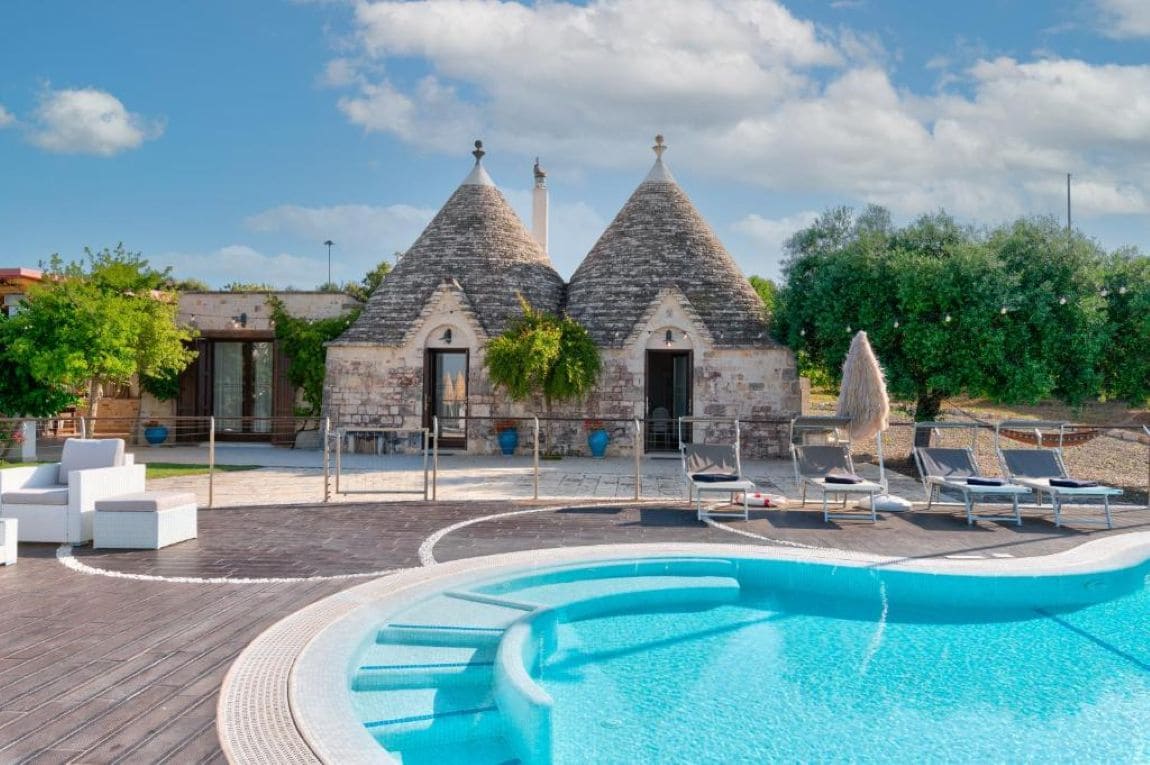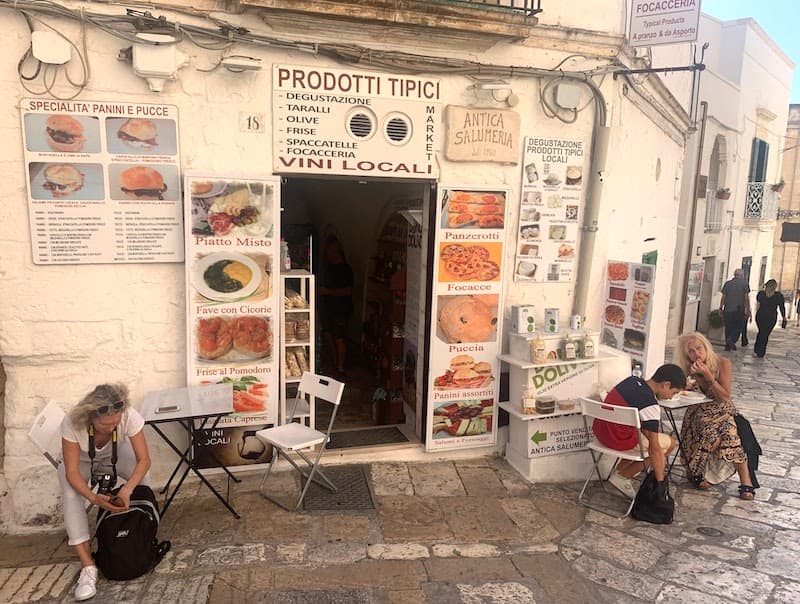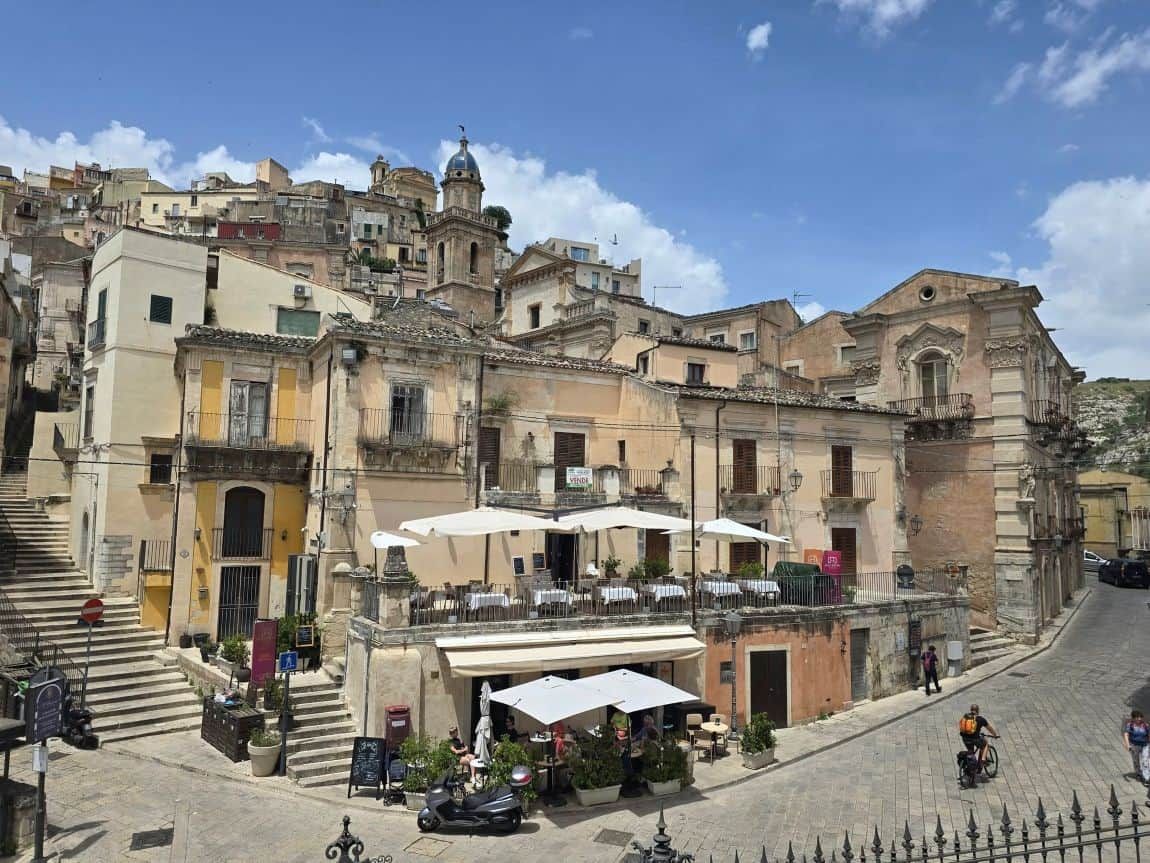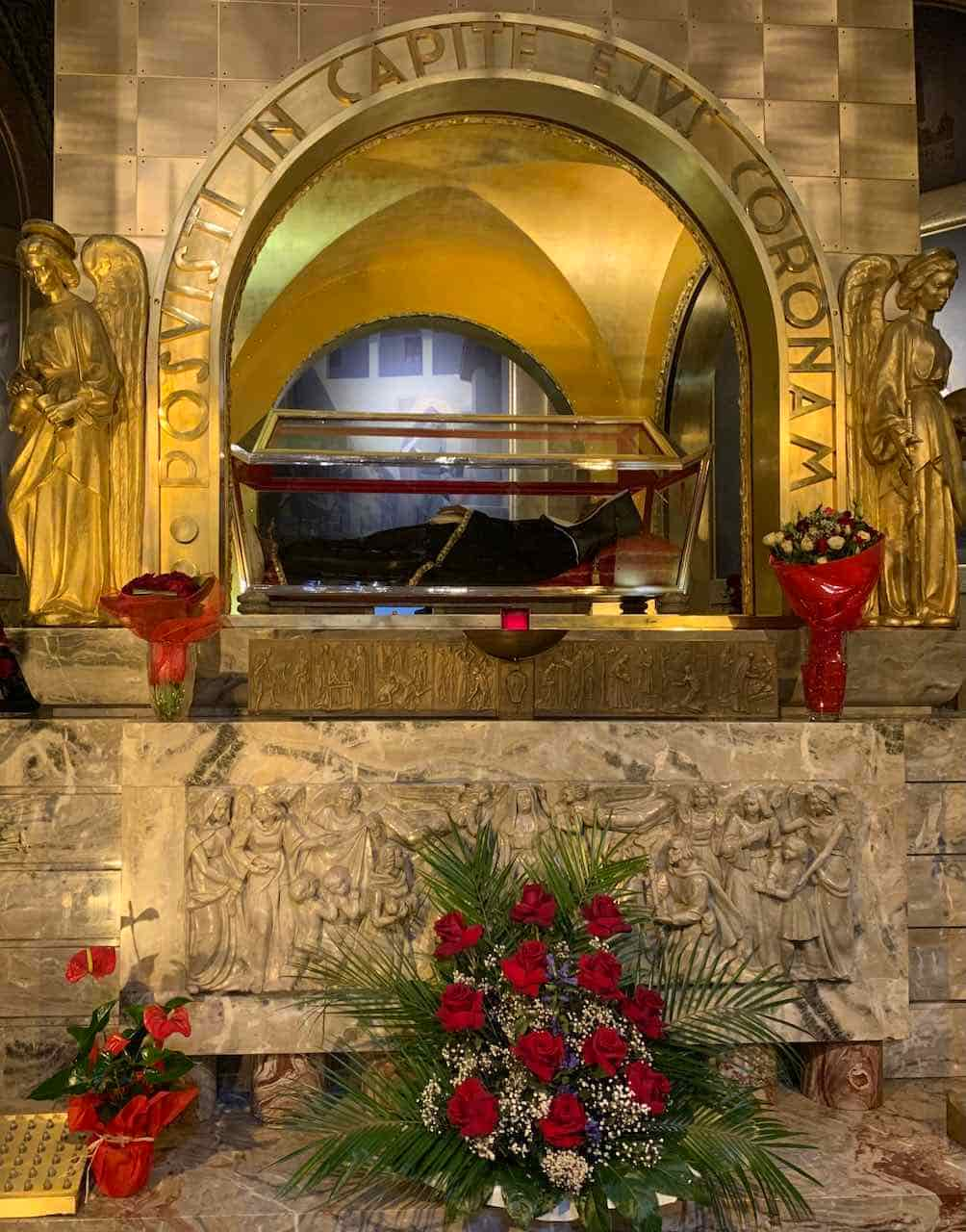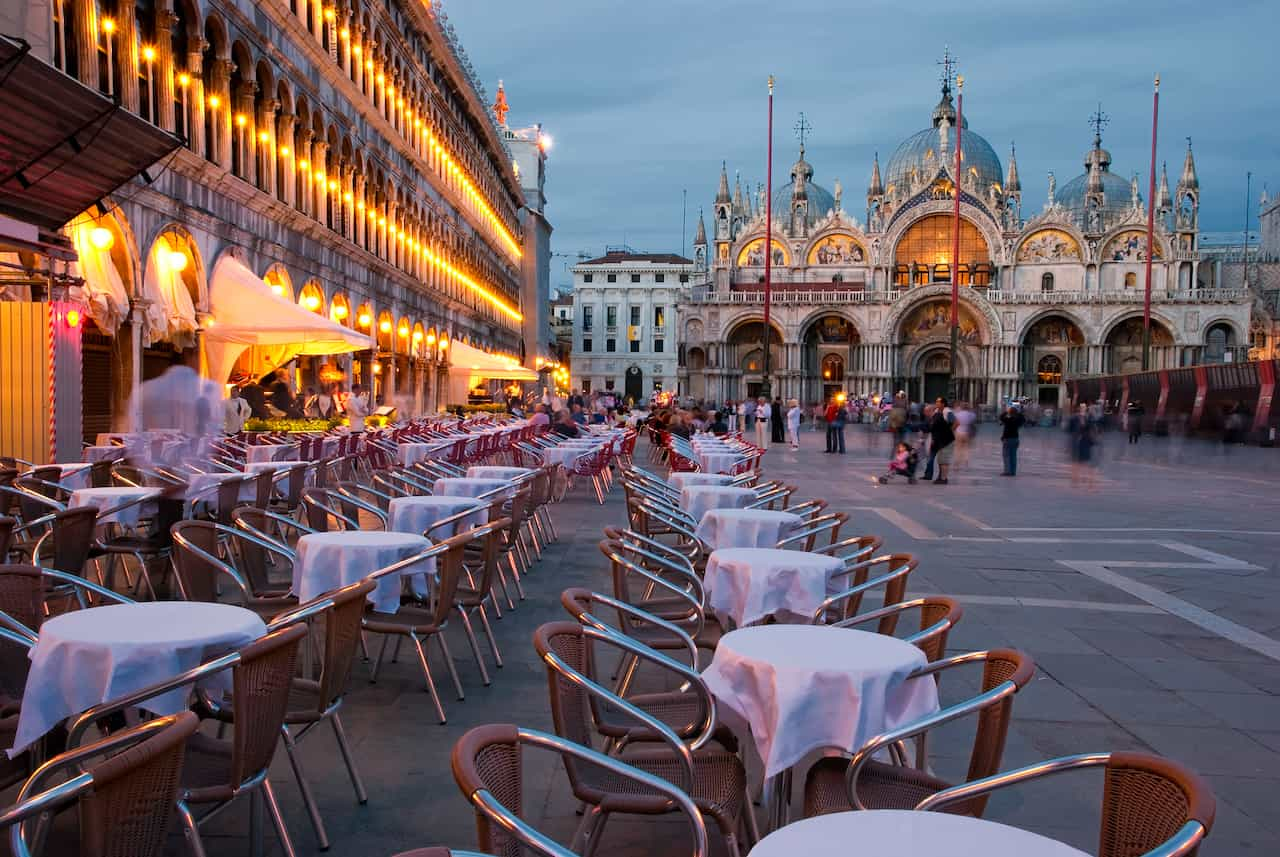9 Dreamy Villages in Val d’Orcia Tuscany You Have to See to Believe
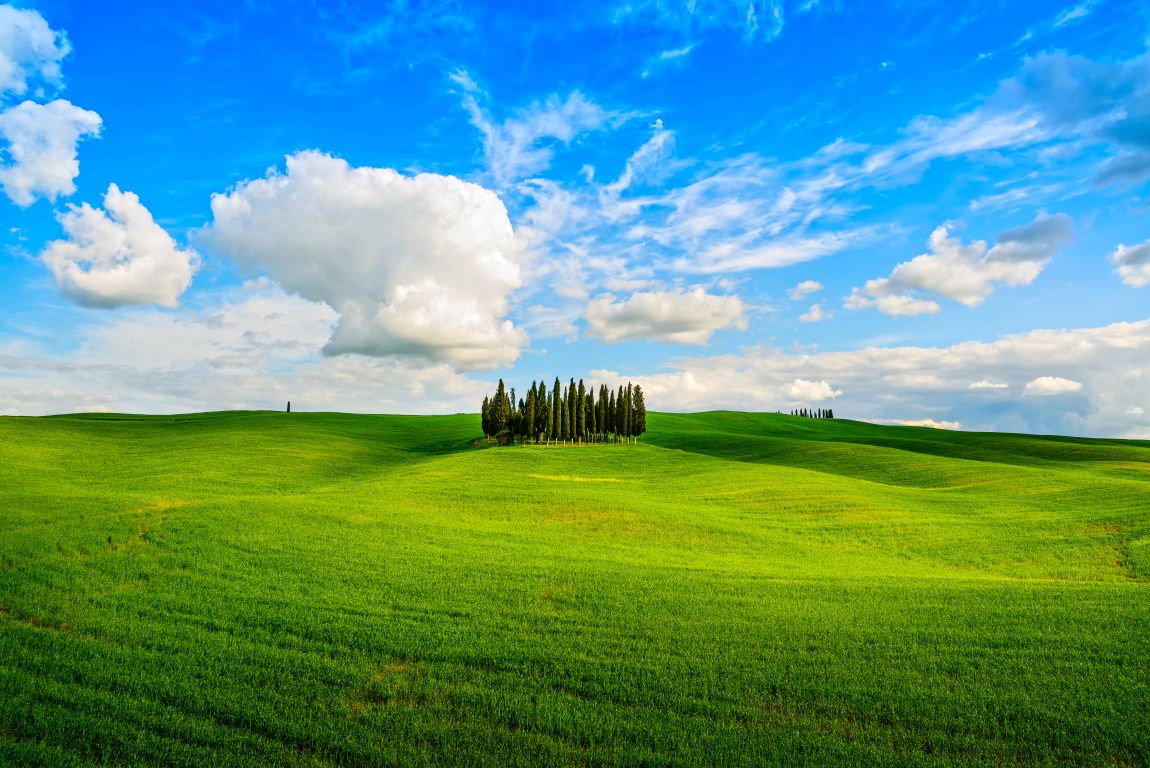
Discover why Val d’Orcia Tuscany is the ultimate Tuscan escape, one picturesque village at a time!
I’ve traveled through Tuscany many times, crisscrossing its hills, its vineyards, its sun-kissed medieval towns. I’ve written about the perfect Tuscany road trip for first-time visitors, the best Tuscan food you simply must try, a 3-day Tuscan itinerary, and unforgettable villas to rent under the Tuscan sun. I’ve shared travel guides to Siena, San Gimignano, Cortona, Arezzo…—each one a gem in its own right.
But if there is one corner of Tuscany that captures the essence of the region more perfectly than anywhere else, it is the Val d’Orcia. This is the Tuscany you dream about before you go—the rolling golden fields, rows of cypress trees leading to stone farmhouses, Renaissance towns perched on hills, and vineyards producing some of Italy’s most legendary wines. If Tuscany is a masterpiece, the Val d’Orcia is its heart.
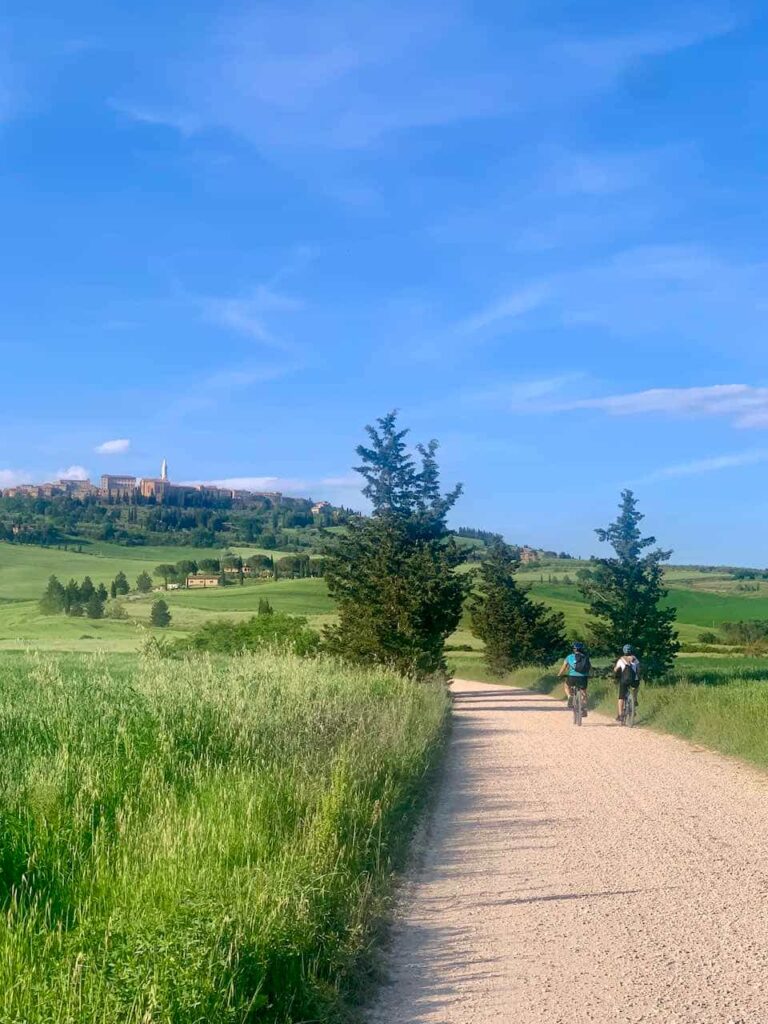
THIS POST MAY CONTAIN COMPENSATED LINKS. PLEASE READ MY DISCLAIMER FOR MORE INFO.
My Go-To Car Rental Company: DISCOVER CAR
I always book rental cars online in advance. Booking a car rental in advance is more money- and time-wise than booking at the airports. I always use Discover Cars. They search international car rental companies and small local car rental agencies to find the best deal for you. Plus, there are no hidden costs, and they offer free cancellation. I always take their full coverage as they offer competitive rates. Check Their Car Rental Prices!
My Go-To Accommodation Platforms:
Booking.com (short stays) and Vrbo (longer stays)
What is Val d’Orcia?

The Val d’Orcia—or Orcia Valley—is a UNESCO World Heritage site stretching south of Siena, brushing up against the volcanic slopes of Monte Amiata. It’s a valley sculpted by time, dotted with medieval villages, Renaissance towns, Romanesque abbeys, hot springs, and dreamlike countryside.
For centuries, it has been both a breadbasket and an inspiration. The ancient pilgrimage route, the Via Francigena, wound its way through here, carrying travelers, merchants, and pilgrims to Rome. Farmers once cultivated the land with devotion, creating the harmonious landscapes we see today—rolling fields, vineyards, olive groves, and lone cypress trees standing like sentinels.
What is Val d’Orcia Famous For?
Val d’Orcia is famous for its beauty, but also for its cultural importance. The entire valley is recognized by UNESCO as an outstanding example of Renaissance planning, where man and nature exist in rare harmony. Its historic villages—Pienza, Montalcino, San Quirico d’Orcia, Radicofani, Bagno Vignoni—are jewels of medieval and Renaissance Italy. The valley is also celebrated for wine: Brunello di Montalcino and Vino Nobile di Montepulciano are both born here. And then there are its hot springs, its truffles, and its pecorino cheese.
Hollywood fell in love with Val d’Orcia, too. The wheat fields and cypress-lined roads appeared in Gladiator, The English Patient, Romeo and Juliet (1968), and The Twilight Saga: New Moon. If you’ve ever seen Russell Crowe walking through golden fields toward his family in Gladiator, you’ve seen Val d’Orcia.
Where is Val d’Orcia?

Val d’Orcia lies in southern Tuscany, south of Siena and north of Lazio. Distances are manageable but deceptive—the beauty of the roads means you’ll want to linger. From Siena, it’s only about 50 km (an hour’s drive). From Florence, expect a two-hour journey (around 120 km). And from Rome, it’s about 180 km, a three-hour drive that feels like an adventure in itself.
How to Get to Val d’Orcia Tuscany
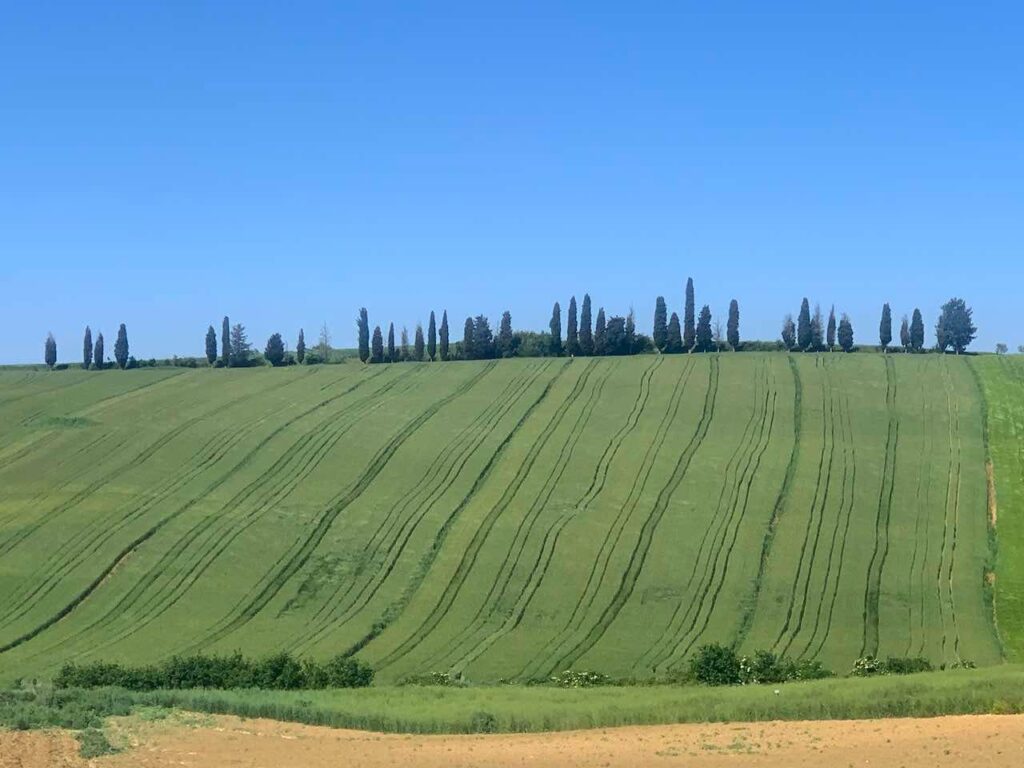
The best way to explore Val d’Orcia is by car. This is road trip country, where every turn brings a view worthy of a Renaissance painting. But if you prefer to take guided tours, there are excellent options:
- From Florence: Val d’Orcia Tour with Wine Tasting
- From Siena: Brunello di Montalcino Guided Wine Tour with Lunch
- From Siena: Pienza and Montepulciano Small-Group Tour
- From Rome: Private Day Tour of Tuscany
These tours allow you to explore the highlights without worrying about the logistics, and they always come with that Tuscan bonus: incredible food and wine.
Places to Visit in Val d’Orcia Italy
These 9 villages in Val d’Orcia Tuscany that will make you fall in love with Tuscany all over again.
1. Pienza

If Tuscany has a model Renaissance town, it is Pienza, the “ideal city” envisioned by Pope Pius II. In the mid-15th century, he transformed his birthplace into a harmonious masterpiece of Renaissance urban planning. Walking into Piazza Pio II feels like stepping into a perfectly proportioned painting: the cathedral, the papal palace, and elegant palazzi frame a square that radiates beauty. From the walls, breathtaking views sweep across the Val d’Orcia, a panorama that never fails to stop you in your tracks.
But Pienza isn’t only about architecture—it is also the kingdom of pecorino cheese. The scent of aging pecorino fills little shops along Corso Rossellino, inviting you to taste everything from young, creamy wheels to mature, herb-crusted varieties. In September, the town hosts a cheese festival where shepherds parade their sheep and villagers play a game of rolling pecorino wheels through the streets.
Nearby, the winding road of Terrapille, known as the “Elysian Fields” in Gladiator, offers cinematic landscapes that seem almost unreal. You’ll want to pause for photos at every bend. Read more: Things to Do in Pienza, Tuscany.
Where to Stay in Pienza:
- Hotel Corsignano – A comfortable stay with sweeping countryside views and a rooftop hot tub.
- Il Giardino Segreto – Charming rooms in a historic building with a hidden garden oasis.
- Relais Il Chiostro di Pienza – Set in a former convent, with a pool overlooking the valley.
2. Montalcino
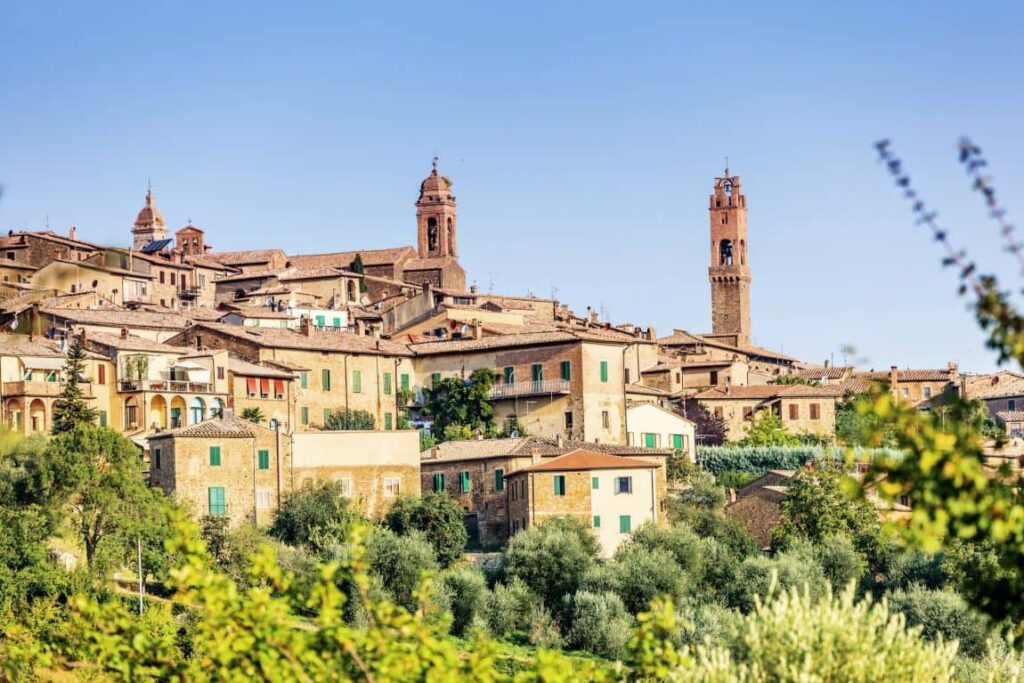
Perched on a hilltop surrounded by vineyards, Montalcino is a medieval town with a global reputation: this is the birthplace of Brunello di Montalcino, one of the world’s greatest wines. From the imposing 14th-century fortress, the Rocca, you can gaze across the patchwork of vineyards, olive groves, and distant Monte Amiata. Inside, wine shops and tasting rooms invite you to sample the richness of Brunello before heading out to visit family-run estates where tradition meets artistry.
Beyond wine, Montalcino offers Romanesque churches, quiet cobblestone lanes, and the magnificent Abbazia di Sant’Antimo, a few kilometers outside town. Built of honey-colored stone and surrounded by olive groves, the abbey is famous for Gregorian chants that echo through its nave, transporting you back centuries.
Montalcino is also a gourmet destination. Many trattorie serve hearty Tuscan fare—pici pasta with ragù, wild boar stew, and aged pecorino. Pairing these with a glass of Brunello is pure bliss.
Where to Stay in Montalcino:
- Castello Banfi – Il Borgo – A luxury wine estate with castle-like charm and vineyards all around, set on a hilltop 10 km from Montalcino.
- Hotel Dei Capitani – Mid-range comfort with a pool and panoramic terrace.
3. San Giovanni d’Asso
If you love truffles, San Giovanni d’Asso is your paradise. This quiet medieval hamlet near Montalcino is home to the first museum in Italy dedicated to truffles, celebrating the prized white and black varieties found in the surrounding woods. In autumn, the Tartufo Bianco Festival fills the streets with the intoxicating aroma of fresh truffles, and chefs serve dishes that highlight their earthy intensity.
The village itself is small but atmospheric, with stone houses, narrow alleys, and the Castello di San Giovanni d’Asso, which hosts the truffle museum. The castle also overlooks olive groves and rolling hills, making it a charming stop between Pienza and Asciano. Here you’ll find Tuscany at its most authentic—slower, less visited, yet deeply rooted in tradition.
This area is also ideal for exploring the Crete Senesi, a dramatic clay landscape with lunar-like hills, gullies, and winding roads that feel otherworldly. Combine a visit here with nearby truffle hunting tours, and you’ll see why this part of Val d’Orcia is so special.
Where to Stay in San Giovanni d’Asso:
- La Locanda del Castello – Boutique hotel in a restored castle, with cozy rooms and a truffle-inspired restaurant.
4. Monticchiello

Tiny, enchanting, and timeless, Monticchiello is one of Val d’Orcia’s most magical hamlets. Encircled by medieval walls and towers, it feels like stepping into another century. The village has fewer than 200 residents, yet its charm lies in its authenticity: laundry flutters from balconies, cats sun themselves on cobblestones, and neighbors greet one another in the piazza.
Monticchiello is also famous for its unique cultural tradition: the Teatro Povero, or “Poor Theatre.” Each summer, the townspeople themselves write, produce, and perform plays in the village square, reflecting on social issues through art and storytelling. It’s a remarkable community effort that has been running for decades.
The views from Monticchiello are nothing short of spectacular. From the ramparts, you can gaze across the “perfect” Val d’Orcia landscape, where golden fields roll toward Pienza in the distance. It’s one of the best vantage points in Tuscany, especially at sunset.
Where to Stay in Monticchiello:
- In Toscana Affittacamere – Family-run guesthouse with panoramic views and Tuscan hospitality.
- Agriturismo Lunadoro – Peaceful countryside retreat with a pool and spacious apartments.
5. San Quirico d’Orcia

San Quirico d’Orcia is a jewel of the valley, perfectly blending history, gardens, and iconic scenery. Once a key stop along the Via Francigena, the ancient pilgrimage route to Rome, the town still preserves its Romanesque churches and medieval charm. The Collegiata Church of San Quirico is a highlight, with its striking stone portals and mix of architectural styles.
One of the town’s treasures is the Horti Leonini, an elegant 16th-century Renaissance garden with geometric hedges and tranquil paths shaded by centuries-old trees. Strolling here feels like stepping into a living painting.
But perhaps San Quirico is most famous for the iconic cypress trees just outside town. Known as the Cipressi di San Quirico, these clusters of trees rising from the rolling hills are among the most photographed sights in Tuscany, embodying the dreamlike allure of Val d’Orcia.
The town also offers cozy wine bars and trattorias where you can savor pici pasta or sip a glass of Brunello. With its blend of history and postcard-perfect landscapes, San Quirico is an essential stop.
Where to Stay in San Quirico d’Orcia:
- Hotel Palazzuolo – Comfortable hotel with a pool and panoramic views over the valley.
- Hotel Palazzo del Capitano Wellness & Relais – Romantic boutique stay with a spa and charming gardens.
- Agriturismo Il Rigo – Iconic farmhouse often featured in Tuscan postcards, set amid rolling fields.
6. Radicofani
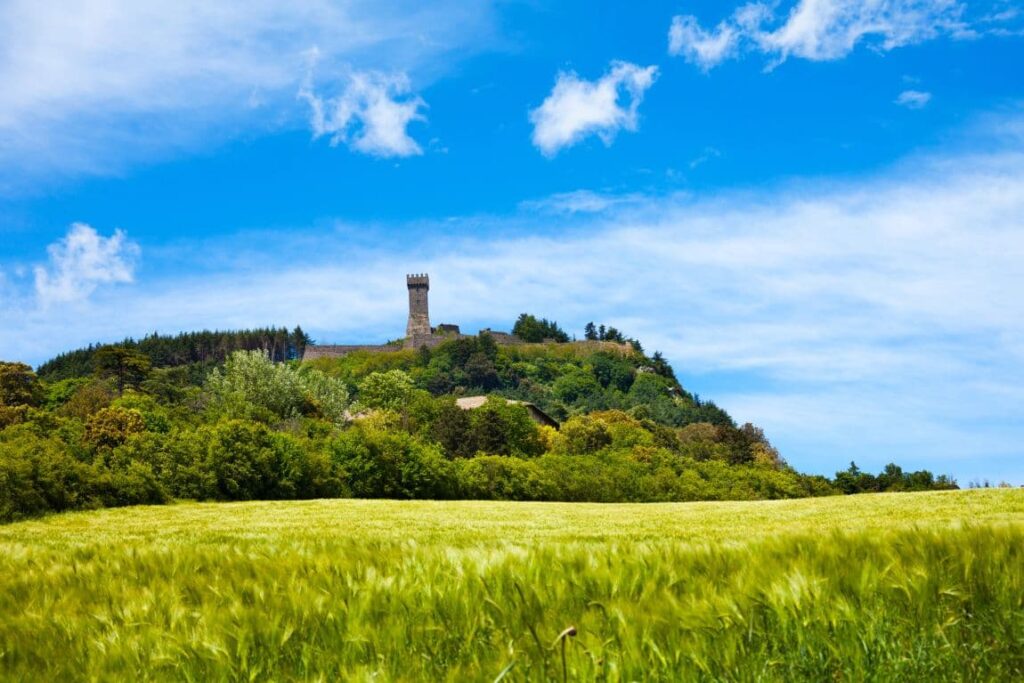
Towering over the southern edge of Val d’Orcia, Radicofani is crowned by an imposing fortress that has watched over the valley since the 9th century. The Rocca di Radicofani, perched on a volcanic outcrop, dominates the landscape. Climb its walls, and you’re rewarded with jaw-dropping views that stretch from Monte Amiata to the Apennines and, on clear days, even to Lazio and Umbria.
Radicofani is also steeped in legend. The fortress was once home to Ghino di Tacco, a noble-turned-outlaw immortalized by Dante and Boccaccio. Part Robin Hood, part bandit, he’s remembered for robbing the rich while sparing the poor. Wandering the village’s narrow streets, you’ll find echoes of this medieval past in its stone houses, churches, and artisan shops.
Despite its dramatic history, Radicofani has a quiet charm. It’s less visited than Pienza or Montalcino, which makes it ideal if you crave authenticity and solitude. With its mix of history, mystery, and spectacular vistas, Radicofani feels like Tuscany’s secret stronghold.
Where to Stay in Radicofani:
- Agriturismo La Selvella – Cozy farmhouse with a pool and rustic charm.
- Podere San Giorgio – Family-run agriturismo with hearty breakfasts and countryside views.
7. Castiglione d’Orcia
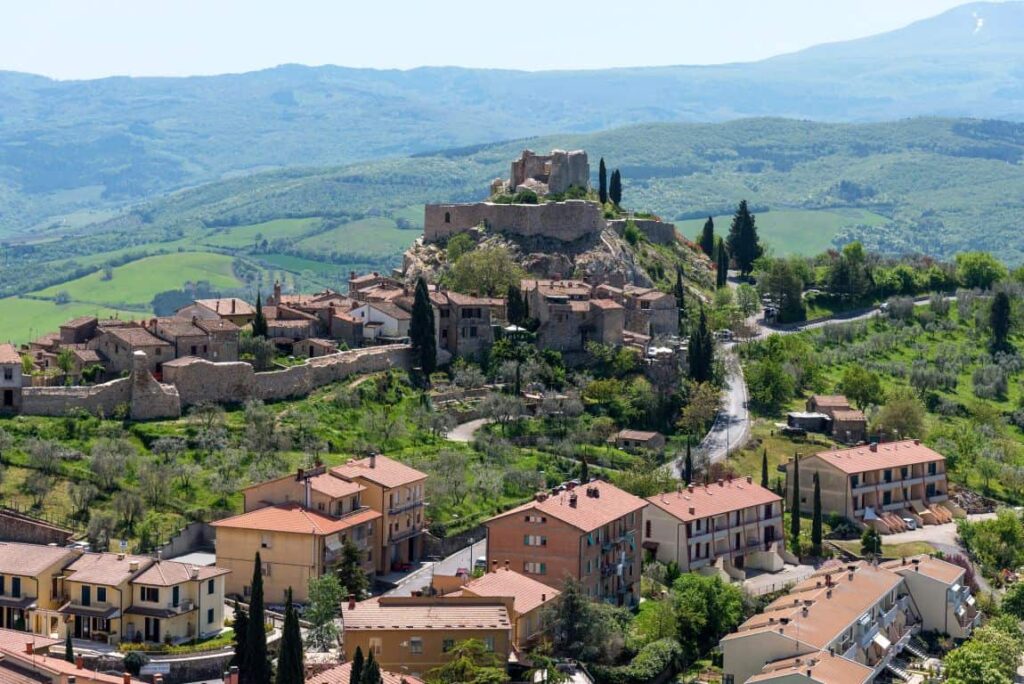
Sitting on a hilltop with a commanding view of the valley, Castiglione d’Orcia is a picturesque medieval town that balances tranquility with history. Its centerpiece is the Rocca a Tentennano, a striking fortress that once controlled the trade routes between Siena and Rome. From its ramparts, the panorama sweeps across the entire Val d’Orcia.
In the town itself, you’ll find cobbled streets, small piazzas, and Romanesque churches. The Church of Santa Maria Maddalena preserves Gothic frescoes, while local trattorias serve hearty Tuscan dishes that taste all the better for being enjoyed in such an authentic setting.
Castiglione is less touristy than neighboring towns, which gives it a wonderfully lived-in feel. It’s the kind of place where you sit in a café, sip an espresso, and watch life unfold slowly. If you’re looking for that sense of Tuscan “slow living,” this is where you’ll find it.
Where to Stay in Castiglione d’Orcia:
- La Locanda in Tuscany – Luxurious yet rustic boutique hotel with infinity pool and vineyards.
- Casa Antica – Cozy, family-run guesthouse with traditional decor.
- Agriturismo Grossola – Peaceful farmhouse with sweeping countryside views.
8. Bagno Vignoni
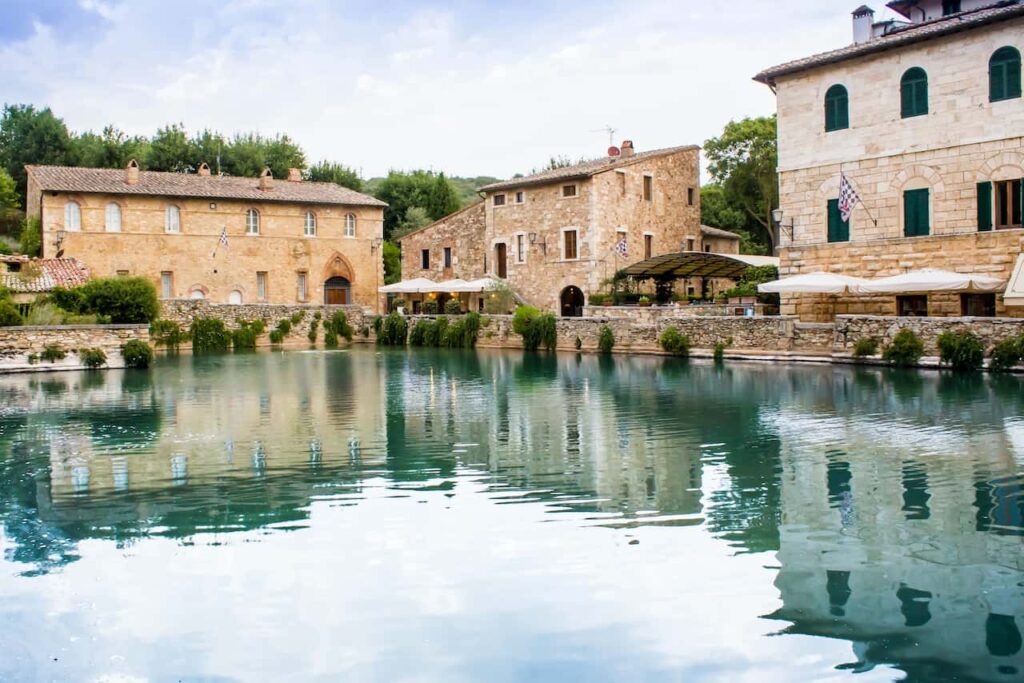
Unlike any other village in Italy, Bagno Vignoni is built around a pool of hot thermal waters in its main square. Instead of a piazza paved with stone, here you’ll find steaming waters once used by saints, popes, and pilgrims. Since Roman times, Bagno Vignoni has been a sanctuary of wellness, and even today, its thermal baths invite relaxation.
The surrounding countryside is dotted with spas and wellness resorts where you can soak in mineral-rich pools while gazing across the hills. Just beyond the town, medieval mills and waterfalls testify to centuries of harnessing the power of these springs.
But Bagno Vignoni isn’t only about wellness—it’s also about atmosphere. With its stone houses, quiet alleys, and warm steam rising into the cool morning air, the village feels magical, especially at sunrise or sunset. It’s a place to slow down, unwind, and let the centuries melt away.
Where to Stay in Bagno Vignoni:
- Adler Spa Resort Thermae – Luxury spa hotel with extensive wellness facilities and thermal pools.
- Le Terme Hotel – Boutique stay right in the village square, steps from the thermal waters.
9. Montepulciano

Technically lying between Val d’Orcia and Val di Chiana, Montepulciano is one of Tuscany’s grandest hill towns. Renaissance palaces line its steep streets, leading up to the Piazza Grande, where the cathedral, town hall, and historic palazzi form a monumental stage. The square has starred in films like Twilight: New Moon, but its real magic lies in its centuries of history.
Montepulciano is world-renowned for its Vino Nobile di Montepulciano, a red wine that has been celebrated since the 14th century. Beneath the town’s streets lie vast wine cellars carved into tufa rock, where you can taste vintages surrounded by centuries-old barrels.
The town itself is endlessly atmospheric. Admire the Torre di Pulcinella, the clock tower topped by a whimsical figure, wander into artisan shops selling copperware and leather, or simply watch the sun sink over the rolling valleys. Montepulciano is equal parts lively and historic, offering both cultural depth and Tuscan indulgence. Read more: Best Things to Do in Montepulciano, Tuscany.
Where to Stay in Montepulciano:
- Palazzo Carletti – Elegant suites in a restored noble palace.
- Villa Poggiano – Luxury villa with pool and parkland, just outside the town walls.
Famous Landmarks and Photo Spots in Val d’Orcia
Cipressi di San Quirico d’Orcia
Four iconic cypress clusters standing in perfect harmony, a postcard symbol of Tuscany. Their symmetry against the rolling fields creates one of the most photographed scenes in Italy. Sunrise and sunset bring the hills to life in golden light. A must-stop for every photographer and dreamer.
Abbazia di Sant’Antimo
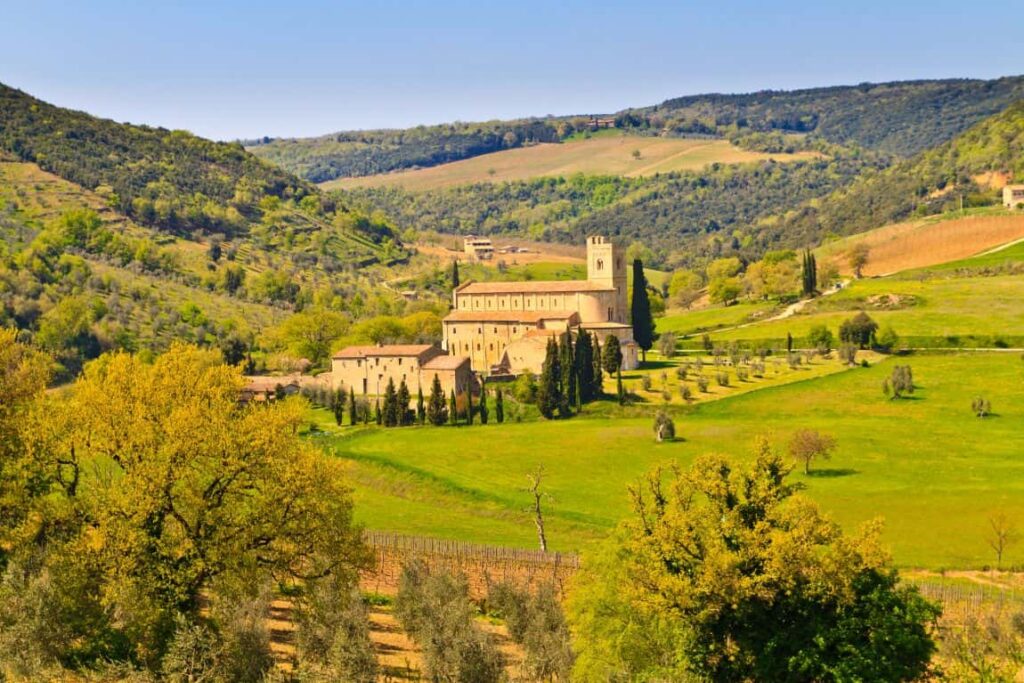
A serene Romanesque abbey outside Montalcino, built of honey-colored stone and surrounded by olive groves. Legend says Charlemagne himself founded it. Gregorian chants still echo inside its walls, offering a timeless experience. Outside, the hills ripple in endless shades of green.
Bagni San Filippo
A natural wonder of hot springs flowing over white limestone formations known as the “White Whale.” Hidden in the woods, it feels like a secret paradise. In cooler months, steaming pools invite you to soak. In summer, it’s a refreshing natural spa.
The Elysian Fields (Terrapille Road)
Perhaps the most cinematic stretch of Val d’Orcia, immortalized in Gladiator. Rolling wheat fields lead to rows of cypresses under open skies. Standing here, you feel transported to another time. It’s Tuscany in its purest essence.
The Chapel of Vitaleta
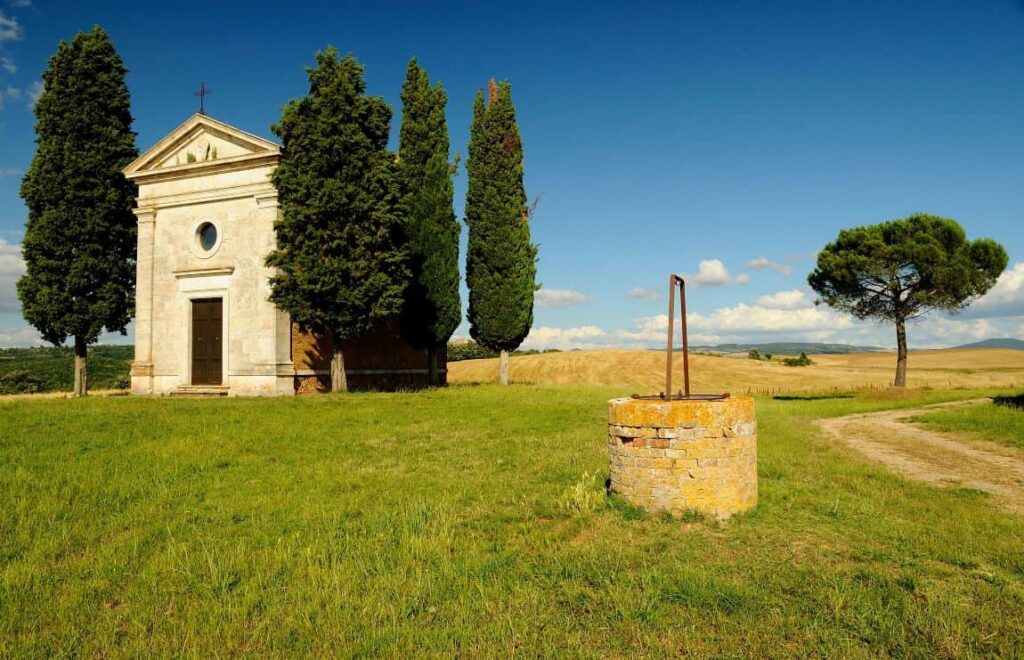
A tiny stone chapel standing solitary among fields, framed by cypresses. Believed to house a Madonna sculpted by Andrea della Robbia, it is both sacred and symbolic. The setting, along the SP146, is pure Tuscan poetry. Its simplicity makes it unforgettable.
Lucciola Bella Nature Reserve
A wild corner of the Crete Senesi near Pienza, with lunar clay hills and untamed landscapes. Nature trails wind through dramatic calanchi and biancane formations. At sunset, the light transforms the hills into glowing sculptures. It’s a photographer’s paradise.
Things to Do in Val d’Orcia Tuscany
Take a road trip along the SP146 between Pienza and San Quirico or the SP53 between San Quirico and Chianciano—roads where beauty never ends. Stay in an agriturismo, the traditional farmhouses offering warm hospitality. Do wine tastings in Montepulciano and Montalcino—join tours like the Brunello Wine Tasting & Lunch in a Tuscan Castle or the Montepluciano Wine Tasting & Lunch in a Typical Winery.
Go on a dairy farm tour with Pecorino tasting in Pienza. Explore the valley by bike on the Guided E-bike Tour from Pienza. Bathe in the hot springs of Bagni San Filippo. Take a cooking class—try the Pasta and Tiramisu Class in Montepulciano or the Tuscan Cooking Class in Pienza. Tour the castles, abbeys, and fortresses—Abbazia di Sant’Antimo, Radicofani fortress, Castello Banfi, Castello di Velona. This is a place where history and pleasure are inseparable.
Food to Try in Val d’Orcia Italy
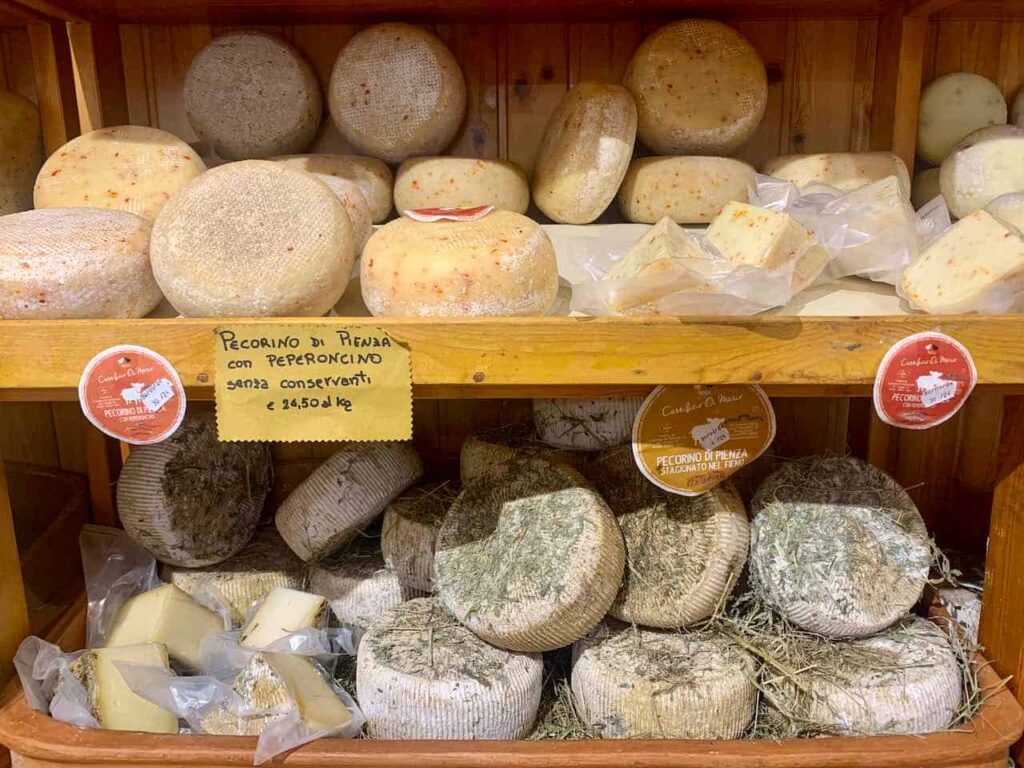
Val d’Orcia is as much about taste as sight. Sip Brunello di Montalcino and Vino Nobile di Montepulciano, two of Italy’s most revered wines. Taste Pecorino di Pienza, a cheese so fragrant it carries the aroma of the wild herbs grazed upon by the sheep. Savor Cinta Senese prosciutto, pici pasta tangled in ragù, rustic ribollita, fresh panzanella, rich salame di cinghiale, and the humble, heartwarming pappa col pomodoro. Every meal here is a story. Read more: Best Traditional Tuscan Food in Tuscany to Treat Yourself With
When to Visit Val d’Orcia
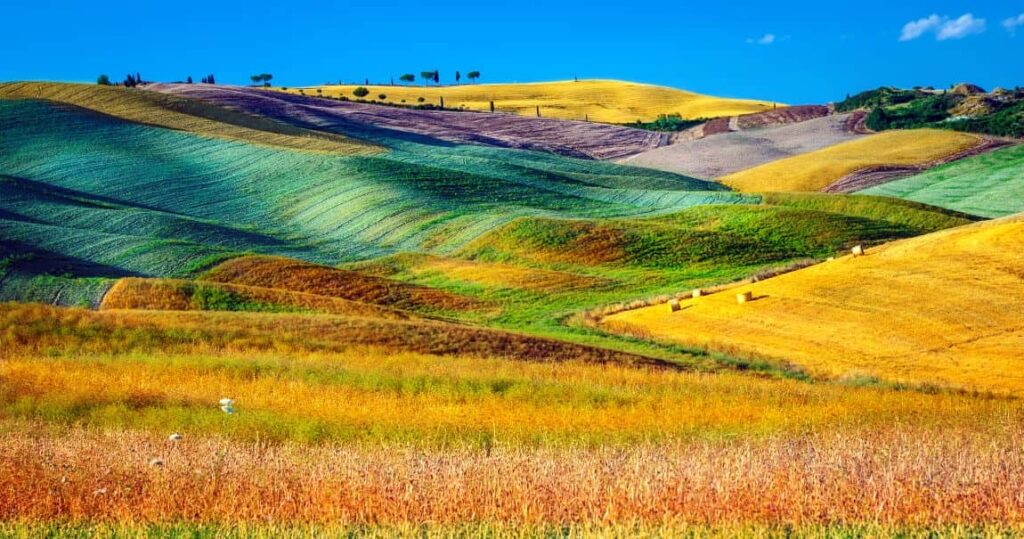
Spring brings wildflowers and soft green hills; summer turns the valley golden; autumn paints it with grape harvests and truffle festivals (Read: 15 Magical Places to Explore Italy in the Fall Right Now). Winter is misty and quiet, perfect for thermal baths. There’s no wrong season, only different moods of the valley.
How Long to Spend in Val d’Orcia
You could see highlights in a day, but to truly feel Val d’Orcia, spend at least three days. An ideal itinerary would start in Pienza, continue to Montalcino and Bagno Vignoni, wander the backroads to San Quirico, explore the fortress of Radicofani, and end with wine in Montepulciano. Stay in an agriturismo farmhouse or a boutique hotel in Pienza or Montalcino—either way, you’ll wake up to views that look like they’ve been painted.
Final Thoughts
Val d’Orcia is a landscape, but also a feeling that seems both eternal and intimate. It is Tuscany distilled into its purest essence: golden fields, medieval villages, Renaissance dreams, and the joy of food and wine shared under the sun. I’ve wandered many parts of Tuscany, but each time I return to Val d’Orcia Italy, it feels like coming home to a dream I never want to wake from.
- The Most Luxurious Secret Castle Hotels in Italy: Romantic Escapes You Won’t Believe You Can Stay In - November 14, 2025
- Vienna, Where Time Waltzes — The Most Magical Things to Do in Vienna, Austria - November 8, 2025
- The Prettiest Castle Hotels in Scotland You’ll Want to Book Right Away - November 7, 2025

